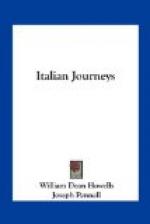There was a dusty quiet within the tomb, and a grassy quiet without, that pleased exceedingly; but though the memories of the place were so high and epic, it only suggested bucolic associations, and, sunken into that nook of hill-side verdure, made me think of a spring-house on some far-away Ohio farm; a thought that, perhaps, would not have offended the poet, who loved and sang of humble country things, and, drawing wearily to his rest here, no doubt turned and remembered tenderly the rustic days before the excellent veterans of Augustus came to exile him from his father’s farm at Mantua, and banish him to mere glory. But I believe most travellers have much nobler sensations in Virgil’s tomb, and there is a great deal of testimony borne to their lofty sentiments on every scribbleable inch of its walls. Valery reminded me that Boccaccio, standing near it of old, first felt his fate decided for literature. Did he come there, I wonder, with poor Fiammetta, and enter the tomb with her tender hand in his, before ever he thought of that cruel absence she tells of? “O donne pietose!” I hope so, and that this pilgrimage, half of love and half of letters, took place, “nel tempo nel quale la rivestita terra piu che tutto l’altro anno si mostra bella.”
If you ascend from the tomb and turn Naplesward from the crest of the hill, you have the loveliest view in the world of the sea and of the crescent beach, mightily jeweled at its further horn with the black Castel dell’ Ovo. Fishermen’s children are playing all along the foamy border of the sea, and boats are darting out into the surf. The present humble muse is not above saying also that the linen which the laundresses hang to dry upon lines along the beach takes the sun like a dazzling flight of white birds, and gives a breezy life to the scene which it could not spare.
IV.
There was a little church on our way back from Posilippo, into which we lounged a moment, pausing at the altar of some very successful saint near the door. Here there were great numbers of the usual offerings from the sick whom the saint had eased of their various ills,—waxen legs and arms from people who had been in peril of losing their limbs, as well as eyes, noses, fingers, and feet, and the crutches of those cured of lameness; but we were most amused with the waxen effigies of several entire babies hung up about the altar, which the poor souls who had been near losing the originals had brought there in gratitude to the saint.
Generally, however, the churches of Naples are not very interesting, and one who came away without seeing them would have little to regret. The pictures are seldom good, and though there are magnificent chapels in St. Januarius, and fine Gothic tombs at Santa Chiara, the architecture is usually rococo. I fancy that Naples has felt the damage of Spanish taste in such things as well as Spanish tyranny in others. Indeed, I saw much there which reminded




